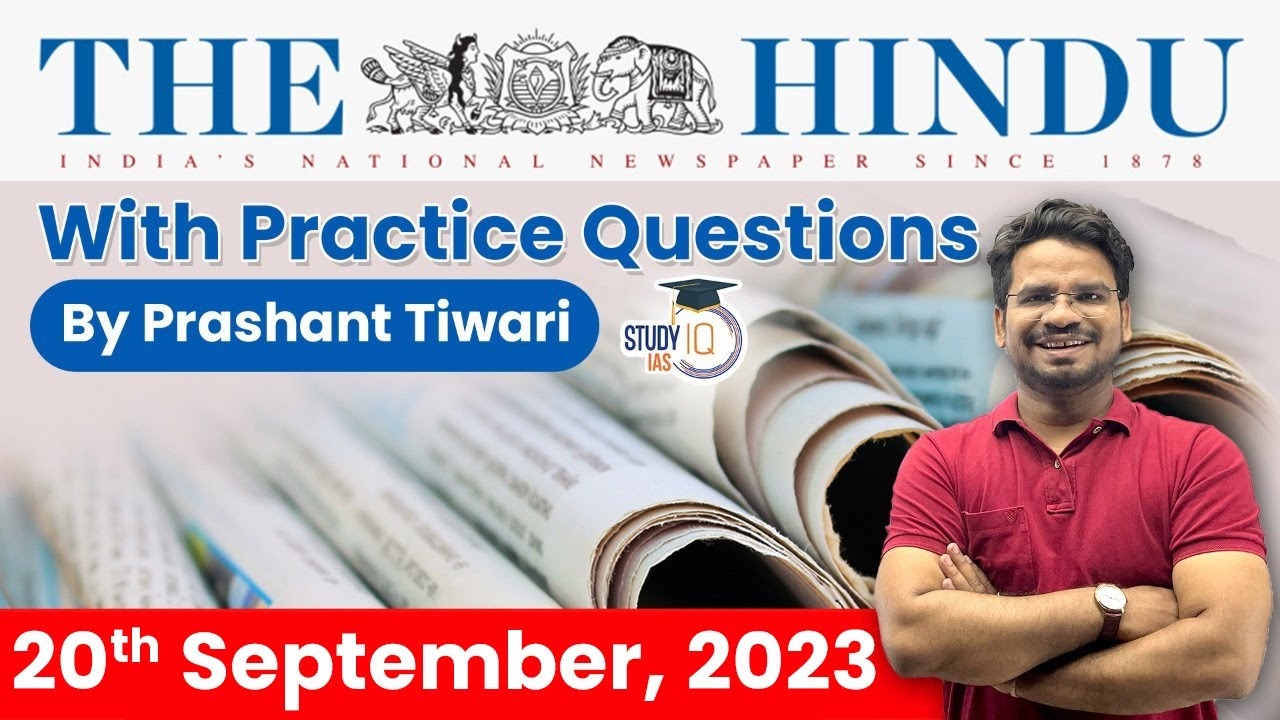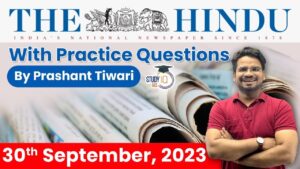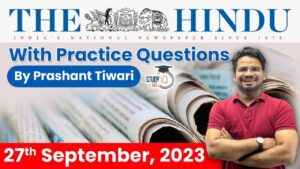The Hindu Newspaper Analysis for UPSC

The Hindu Newspaper Analysis 18 September 2023
- India on Tuesday rejected the Canadian allegation of involvement by the Government of India in the killing of a prominent Khalistani separatist leader “on Canadian soil”.
- It was in June that Khalistan Tiger Force chief Hardeep Singh Nijjar was gunned down by unidentified assailants in the Surrey city of Canada.
- In a tough statement, the Ministry of External Affairs (MEA) said allegations made by Canadian Prime Minister Justin Trudeau diverted attention from the activities of Khalistan operatives in Canada, and called for effective action against them. In a tit-for-tat move, India expelled a senior Canadian diplomat after Canada expelled a diplomat from the Indian High Commission in Ottawa.
The Hindu Editorial Today
- Background
- India’s Punjab state – which is about 58% Sikh and 39% Hindu – was rocked by a violent Khalistan separatist movement in the 1980s and early 1990s, in which thousands of people died.
- Recently, Hardeep Singh Nijjar was shot dead in Surrey, British Columbia.
- Nijjar had campaigned for an independent Sikh nation – known as Khalistan – to be carved out of India’s Punjab state.
- He was wanted by Indian authorities and had been designated as a “terrorist” in July 2020.
- Hardeep Singh Nijjar was chief of the Khalistan Tiger Force.
- India has designated the Khalistan Tiger Force as a terrorist outfit.
- This incident led to speculation on social media about whether the Indian intelligence agencies were linked to these deaths abroad, including on Canadian soil.

-
- In a historic move after the Special Session shifted to the new Parliament House on Tuesday, the Narendra Modi government introduced the women’s reservation Bill in the Lok Sabha to reserve one-third of the seats in the Lower House and the Assemblies for women.
- The Constitution (One Hundred and Twenty Eighth) Amendment Bill, 2023, however, would be implemented only after the 2026 delimitation exercise using data from the Census to be conducted after the passage of the Bill this year. The reservation in the Lok Sabha can hence be implemented only in the Lok Sabha election in 2029 and not in 2024.
- The PM appealed to both Houses to pass the Bill by a consensus.
- Union Law Minister Arjun Meghwal, who introduced the Bill, said going by the House’s current strength, the number of women members would rise to 181 from 82 once the law comes into force.
- The Rajya Sabha passed the Women’s Reservation Bill on 9 March 2010. However, the Lok Sabha never voted on the bill. The bill lapsed since it was still pending in Lok Sabha.
- The issue of reservation for women in politics can be traced back to the Indian national movement. In 1931, in their letter to the British Prime Minister, submitting the official memorandum jointly issued on the status of women in the new Constitution by three women’s bodies, leaders Begum Shah Nawaz and Sarojini Naidu.
- The National Perspective Plan for Women recommended in 1988 that reservation be provided to women right from the level of the panchayat to that of Parliament

- The Hoysala temples at Belur, Halebid, and Somanathapur in Karnataka were declared UNESCO World Heritage Sites on Monday in a move that will bring global recognition with prospects of increase in international tourism to these places.
- The Chennakeshava temple at Belur and the Hoysaleshwara temple at Halebid — both in Hassan district — have been on the UNESCO’s tentative list since 2014. The Keshava temple at Somanathapur in Mysuru district was appended to the other two monuments under the tentative list and all three were officially nominated by the Centre as India’s entry for 2022-23 in February 2022.
- All three temples are protected by the ASI and the nominations were entered as ‘The Sacred Ensembles of Hoysalas’. The Hoysala temples are known for evolving a distinct style that is ornate with temple architecture following a stellate plan built on a raised platform. The material used in temple construction is chlorite schist which is also known as soapstone that are soft and amiable to carving.
- The temples have horizontal friezes and many of the sculptures are signed by artists which is unique in the history of Indian art while the doorways show intricate carvings showcasing the excellence achieved by the artist.

- Hoysala architecture, developed between the 11th and 14th centuries in southern Karnataka under the Hoysala Empire, is characterized by:
- A unique style blending elements of Dravida and Nagara architectures.
- Influences from Bhumija, Nagara, and Karntata Dravida architectural traditions.
- Distinctive ‘Hoysala Temple’ form with multiple shrines around a central pillared hall in a star-shaped layout.
- The use of soapstone, allowed intricate carving of sculptures, especially in the jewelry adorning temple walls.
What is a World Heritage site?
- A World Heritage Site is an area or object listed on the UNESCO World Heritage List, recognized for its “outstanding universal value” under the Convention Concerning the Protection of the World Cultural and Natural Heritage 1972.
- These sites, categorized into three types – Cultural, Natural, and Mixed, are internationally acknowledged for their cultural, natural, or combined significance.
- As of 2023, there are 42 World Heritage Sites located in India. Out of these, 34 are cultural, 7 are natural, and one, the Khangchendzonga National Park, is of mixed type. India has the sixth-largest number of sites in the world.

- To begin with, it is clear that the desire to support multilateralism is what drove the concessions made in order to achieve consensus at the G-20. The ‘western bloc’ comprising the G-7 countries (Canada, France, Germany, Italy, Japan, the United Kingdom, and the U.S.), the European Union (EU), and U.S. allies Australia and South Korea made the larger part of these concessions by agreeing to the removal of direct pointers to Russia in the operative paragraphs that referred to the war in Ukraine.
- Support for a multipolar world
- In development economics, however, it is clear that the Global South is now seen as the third pole, and many global powers are coming to terms with its worth. While the Global South, made up of more than 125 countries, may not compare in wealth with the ‘North’, it is increasingly becoming a voice to be heard — a voice which resets the priorities at the global forum on issues such as development, climate change, health and the digital divide.


- Cauvery (or Kaveri) is the largest river in the state and originates at Talakaveri at Talakaveri in the Brahmagiri hills of the Western Ghats in Karnataka.
- It is often called the Dakshina Ganga (the Ganges of the South) and considered one of the sacred rivers of India.
- The origin of the River Kaveri, is a famous pilgrimage and tourist spot set amidst Bramahagiri Hills near Madikeri in Coorg.
- The tributaries of the Kaveri include:
- Harangi, Hemavathi (origin in western Ghats joins the river Kaveri near Krishnarajasagar), Lakshmanatirtha,
- Kabini (originates in Kerala and flows eastward and joins the Kaveri at Tirumakudal, Narasipur),
- Shimsha, Arkavati, Suvarnavathi or Honnuholé, Bhavani, Lokapavani, Noyyal, Amaravati.
- About
- The dispute is related to a long-standing conflict over the sharing of water from the Cauvery River.
- It involves 3 states and one Union Territory: Tamil Nadu, Kerala, Karnataka and Puducherry.
- The dispute revolves around how the river water should be distributed among these states for various uses, including irrigation, drinking water, and industrial purposes.
- Background
- This dispute originated for the first-time way back in 1892 at the time of Britishers between the Presidency of Madras and Princely state of Mysore.
- In 1924 Mysore and Madras reached into an agreement which will be valid for 50 years. Hence, it ceased to be enforced in 1974.
- Since 1974, Karnataka started diverting water into its four newly made reservoirs, without the consent of Tamil Nadu.
- The apex court delivered its judgement in 2018. In its judgement, the apex court declared Cauvery a national asset.
- It largely upheld the water-sharing arrangements finalised by the CWDT.
- As per the judgement, Karnataka would get 284.75 TMC, Tamil Nadu 404.25 TMC, Kerala 30 TMC and Puducherry 7 TMC.
- It also directed the Centre to notify the Cauvery Management Scheme.
- The central government notified the ‘Cauvery Water Management Scheme’ in June 2018.
- It constituted the ‘Cauvery Water Management Authority’ (CWMA) and the ‘Cauvery Water Regulation Committee’ (CWRC) to give effect to the decision.

- Nearly a year after deciding to cut the number of prizes annually awarded by its Ministries, the Union government is set to institute the Rashtriya Vigyan Puraskar — 56 prizes to felicitate scientists, technologists and innovators. Akin to the prestigious Padma awards, these awards will not include any cash component; instead, they will likely bestow a certificate and a medallion on the awardee, sources told The Hindu.
- According to the proposal seen by The Hindu, which is yet to be made public, the RVP will comprise three Vigyan Ratna, 25 Vigyan Shri, 25 Vigyan Yuva-Shanti Swarup Bhatnagar and three Vigyan Team awards.
- hese prizes will be awarded annually for physics, chemistry, biological sciences, mathematics and computer science, earth science, medicine, engineering science, agricultural science, environmental science, technology and innovation, atomic energy, space science and technology, and a 13th category, simply called “others”.
- In their previous avatar, the prizes also had a significant cash component. The Shanti Swarup Bhatnagar (SSB) awards, given by the Council of Scientific and Industrial Research (CSIR) since 1958, now includes ₹5 lakh per winner, as well as a salary perk.

- Approximately four of every five people with hypertension are not adequately treated, but if countries can scale up coverage, 76 million deaths could be averted between 2023 and 2050, the World Health Organization (WHO) said in its first-ever report on the global impact of high blood pressure on Tuesday.
- Hypertension is the most important risk factor for death and disability in India, according to a paper in The Lancet, regional health (Southeast Asia), published late last year. It adds that less than one-fourth of hypertensive patients in India had their blood pressure under control during 2016-2020. Though this rate has improved from the previous years’ figures, substantial differences exist across regions.
- The Lancet paper says the 2019-20 National Family Health Survey (NFHS-5) reported a hypertension prevalence of 24% in men and 21% among women, an increase from 19% and 17%, respectively, from the previous round (2015-16). The India Hypertension Control Initiative, a large-scale hypertension intervention under the National Health Mission, has been recognised for its positive work done within the primary healthcare system.

- The Constitution was envisioned as a living document capable of morphing with the needs of the times. Article 368 governs the process of amending the Constitution.
- The Constitutional provisions that require ratification by States in order to be amended are specifically listed in the proviso to Article 368(2) and pertain to the federal structure of the Constitution. They are commonly referred to as ‘entrenched provisions’.
- In August 2018, the Law Commission of India, chaired by Justice B. S. Chauhan, released a draft report stipulating that simultaneous elections are not feasible within the existing framework of the Constitution.
- In Kihoto Hollohan versus Zachillhu (1992) popularly known as the Anti-Defection case, the constitutional validity of the Tenth Schedule of the Constitution inserted by the Constitution (Fifty-second Amendment) Act, 1985 was challenged on the grounds that the amendment was not ratified by the States.
- Though the Tenth Schedule was to deal with defection, it also purported to oust the jurisdiction of all courts by virtue of Paragraph 7. The amendment brought about changes with respect to the jurisdiction of the Supreme Court and the High Courts — one of the provisions that require ratification by half of the States.
- A Constitution Bench of the Supreme Court upheld the validity of the Tenth Schedule but declared Paragraph 7 of the Schedule invalid for want of ratification.


 The Hindu Newspaper Analysis 6 October 2...
The Hindu Newspaper Analysis 6 October 2...
 The Hindu Newspaper Analysis 30 Septembe...
The Hindu Newspaper Analysis 30 Septembe...
 The Hindu Newspaper Analysis 27 Septembe...
The Hindu Newspaper Analysis 27 Septembe...





















